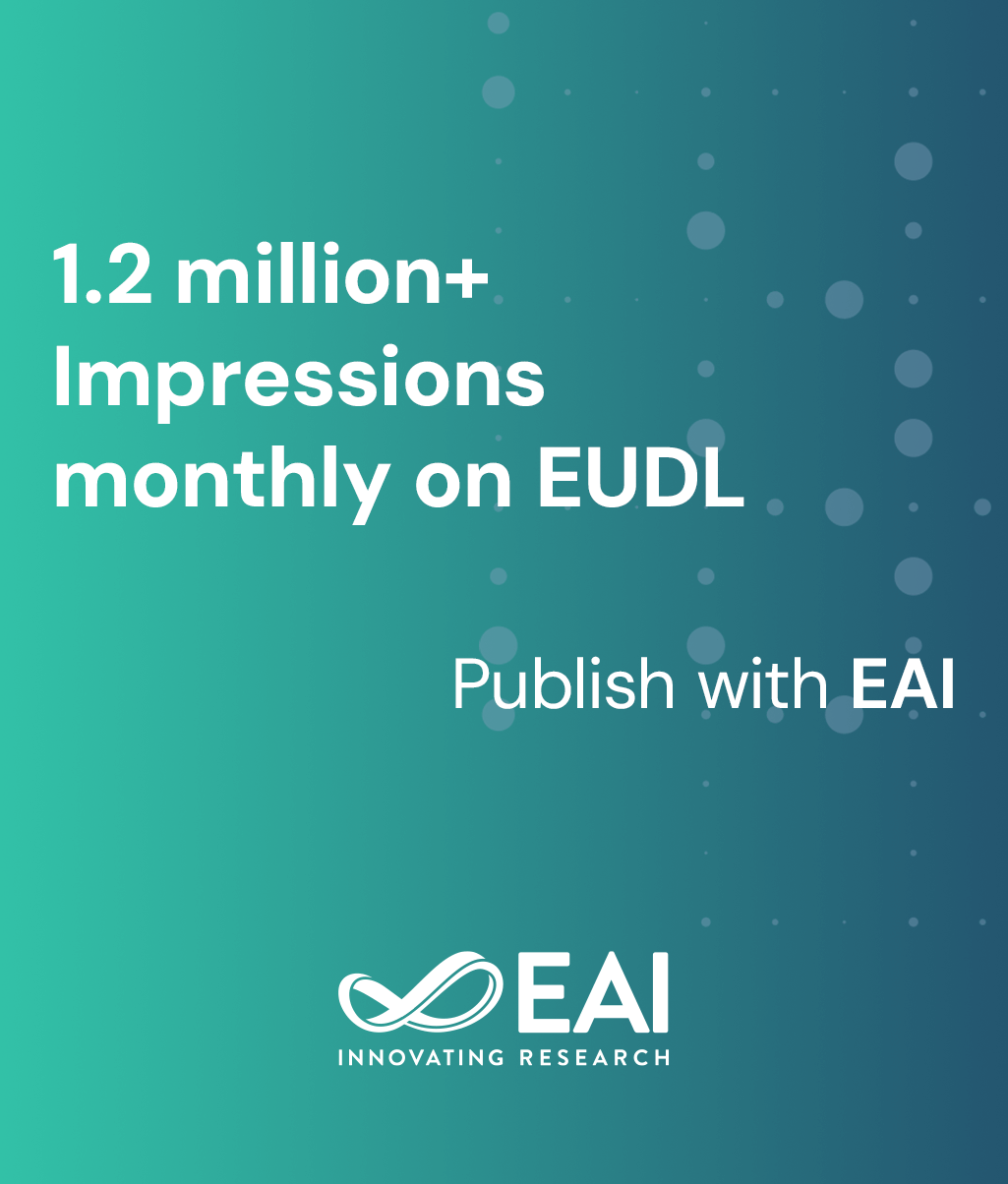
Research Article
A Review of the Methods and Techniques Used in Tourism Demand Forecasting
@ARTICLE{10.4108/eetct.v9i31.2986, author={R. Shakir Al Jassim and Karan Jetly and Ahmad Abushakra and Sh Al Mansori}, title={A Review of the Methods and Techniques Used in Tourism Demand Forecasting}, journal={EAI Endorsed Transactions on Creative Technologies}, volume={9}, number={4}, publisher={EAI}, journal_a={CT}, year={2022}, month={1}, keywords={Social media, Forecasting Tourism Demand, Web traffic, Search Engines, Forecasting Methods}, doi={10.4108/eetct.v9i31.2986} }- R. Shakir Al Jassim
Karan Jetly
Ahmad Abushakra
Sh Al Mansori
Year: 2022
A Review of the Methods and Techniques Used in Tourism Demand Forecasting
CT
EAI
DOI: 10.4108/eetct.v9i31.2986
Abstract
The purpose of this paper is to discuss the methodology and results of researchers who conducted a study concerning the forecasting of tourism demand. In more detail, this study aims to examine and assess various studies about search engines, web traffic data, and social media data, specifically. Using an extensive database of indexed articles, we conducted the review with the goal of providing a solid understanding of the literature. The findings of our study revealed that few researchers integrate different data sources when forecasting tourism demand. Therefore, the authors of this paper decided to conduct a systematic review to provide researchers with a comprehensive overview of the importance of such data. This paper may inspire Omani researchers to undertake similar research based on its findings, which is currently lacking. Thus, this paper will improve understanding of how data sources affect forecasting accuracy and how modern technologies can support economic growth.
Copyright © 2023 R. Shakir Al Jassim et al., licensed to EAI. This is an open access article distributed under the terms of the CC BY-NC-SA 4.0, which permits copying, redistributing, remixing, transformation, and building upon the material in any medium so long as the original work is properly cited. Copyright © Marcello M. Mariani, Rodolfo Baggio, Dimitrios Buhalis, and Christian Longhi. [21] Miah, S. J., Vu, H. Q., Gammack, J., and McGrath, M. (2017) A Big Data Analytics Method for Tourist Behaviour Analysis. Information and Management, 54(6), 771–785. doi:10.1016/j.im.2016.11.011 [22] Nikolopoulos, K., Metaxiotis, K., Assimakopoulos, V., and Tavanidou, E. (2003), A first approach to eforecasting: a survey of forecasting web-services’, Information Management and Computer Security, Vol 11, No 3, pp 146–152. [23] Önder, Irem (2017) Forecasting tourism demand with Google trends: Accuracy comparison of countries versus cities. International Journal of Tourism Research,doi:10.1002/jtr.2137. [24] Önder, I., Gunter, U., ans Gindl, S. (2019) Utilizing Facebook Statistics in Tourism Demand Modeling and Destination Marketing. Journal of Travel Research, 1-14, 004728751983596. doi:10.1177/0047287519835969. [25] Önder, I., Gunter, U., and Scharl, A. (2019) Forecasting tourist arrivals with the help of web sentiment: A mixedfrequency modeling approach for big data. Tourism Analysis, 24(4), 437–452. [26] Park, S., Lee, J., and Song, W. (2017) Short-term forecasting of japanese tourist inflow to south korea using google trends data. Journal of Travel Tourism Marketing, 34(3): 386–397. doi:10.1016/j.tourman.2014.07.019. [27] Pan, B., Wu, D. C., and Song, H. (2012) Forecasting hotel room demand using search engine data. Journal of Hospitality and Tourism Technology, 3(3), 196–210. [28] Rob Law, Gang Li, Davis Ka Chio Fong, Xin Han (2019) Tourism demand forecasting: A deep learning approach, Annals of Tourism Research, Volume 75,Pages 410-423,ISSN 0160-7383, https://doi.org/10.1016/j.annals.2019.01.014. [29] Sangkon Park, Jungmin Lee and Wonho Song (2016) Short-term forecasting of Japanese tourist inflow to South Korea using Google trends data, Journal of Travel and Tourism Marketing, DOI: 10.1080/10548408.2016.1170651 [30] Schaer, Oliver; Kourentzes, Nikolaos; Fildes, Robert (2018) Demand forecasting with usergenerated online information. International Journal of Forecasting, S0169207018300505. doi:10.1016/j.ijforecast.2018.03.005. [31] Sun, S., Wang, S., Wei, Y., Yang, X., and Tsui, K.-L. (2017) Forecasting tourist arrivals with machine learning and internet search index.IEEE International Conference on Big Data (Big Data).doi:10.1109/bigdata.2017.8258439. [32] Song, H., and Li, G. (2008) Tourism demand modelling and forecasting : A review of recent research. Tourism Management, 29(2), 203–220. doi:10.1016/j.tourman.2007.07.016 [33] Theologos Dergiades, Eleni Mavragani, Bing Pan (2018), Google Trends and tourists’ arrivals: 11 EAI Endorsed Transactions on Creative Technologies Online First R. Shakir Al Jassim et al. Emerging biases and proposed corrections,Tourism Management, Volume 66, Pages 108-120, ISSN 02615177, https://doi.org/10.1016/j.tourman.2017.10.014. [34] Volchek, K., Liu, A., Song, H., Buhalis, D. (2018) Forecasting tourist arrivals at attractions: Search engine empowered methodologies. Tourism Economics, 135481661881155. doi:10.1177/1354816618811558 [35] Xiang, Z., Schwartz, Z., Gerdes, J. H., and Uysal, M. (2015) What can big data and text analytics tell us about hotel guest experience and satisfaction? International Journal of Hospitality Management, 44, 120–130. doi:10.1016/j.ijhm.2014.10.013. [36] Yuan, Fong-Ching (2020) Intelligent forecasting of inbound tourist arrivals by social networking analysis. Physica A: Statistical Mechanics and its Applications, 124944–. doi:10.1016/j.physa.2020.124944. [37] Yang, Y., Pan, B., and Song, H. (2014) Predicting hotel demand using destination marketing organization’s web traffic data. Journal of Travel Research, 53(4), 433–447. [38] Yang, X., Pan, B., Evans, J. A., and Lv, B. (2015) Forecasting Chinese tourist volume with search engine data. Tourism Management, 46, 386–397. doi:10.1016/j.tourman.2014.07.019. Acknowledgement The research leading to these results has recieved funding from the Research Council (TRC) of the Sultanate of Oman under the Block Funding Program. TRC Block Funding Agreement No. MoHERI/BFP/UTAS/2022 12 EAI Endorsed Transactions on Creative Technologies Online First


